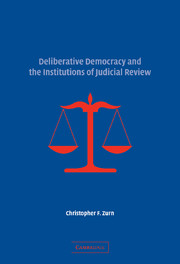Book contents
- Frontmatter
- Contents
- Acknowledgments
- 1 Introduction
- 2 Majoritarian Democracy and Minoritarian Constitutionalism
- 3 From Majoritarian to Deliberative Theories of Constitutional Democracy
- 4 Deliberative Democracy and Substantive Constitutionalism
- 5 Disagreement and the Constitution of Democracy
- 6 The Seducements of Juristic Discourse as Democratic Deliberation
- 7 Constitutionalism as the Procedural Structuring of Deliberative Democracy
- 8 The Institutions of Constitutional Review I: Design Problems and Judicial Review
- 9 The Institutions of Constitutional Review II: Horizontal Dispersal and Vertical Empowerment
- Bibliography
- Index
- Table of Cases
9 - The Institutions of Constitutional Review II: Horizontal Dispersal and Vertical Empowerment
Published online by Cambridge University Press: 18 July 2009
- Frontmatter
- Contents
- Acknowledgments
- 1 Introduction
- 2 Majoritarian Democracy and Minoritarian Constitutionalism
- 3 From Majoritarian to Deliberative Theories of Constitutional Democracy
- 4 Deliberative Democracy and Substantive Constitutionalism
- 5 Disagreement and the Constitution of Democracy
- 6 The Seducements of Juristic Discourse as Democratic Deliberation
- 7 Constitutionalism as the Procedural Structuring of Deliberative Democracy
- 8 The Institutions of Constitutional Review I: Design Problems and Judicial Review
- 9 The Institutions of Constitutional Review II: Horizontal Dispersal and Vertical Empowerment
- Bibliography
- Index
- Table of Cases
Summary
This chapter continues the institutional design proposals started in the previous, turning to four different types of modification in the system of constitutional review. I consider, in turn, the establishment of self-review panels in the legislative and executive branches of national governments (A), various mechanisms for interbranch debate and decisional dispersal concerning constitutional elaboration (B), easing constitutional amendability requirements in overly obdurate systems (C), and finally establishing civic constitutional fora as replacements for traditional amendment procedures (D). In each case, the proposals are motivated by the problems of judicial review I identified in the previous chapter, and their design is oriented to the fullest realization of the six assessment values I specified there. I assume throughout that some form of judicial review is extant in the political system, and for the most part I assume the concentrated system with specialized constitutional courts argued for there. Where something important hangs on the difference between a concentrated and diffuse system of constitutional courts for the design of these other mechanisms for constitutional elaboration, I take that up in the discussion.
Let me turn now to some simpler proposals that could help to mitigate the various kinds of structural sensitivity deficits and potential jurisdictional and empowerment pathologies of constitutional courts. Recall that the basic idea here is to disperse the inevitable processes of constitutional elaboration both horizontally across the various organs of government and vertically throughout the various levels of the formal and informal public spheres.
- Type
- Chapter
- Information
- Deliberative Democracy and the Institutions of Judicial Review , pp. 301 - 341Publisher: Cambridge University PressPrint publication year: 2007
- 1
- Cited by



